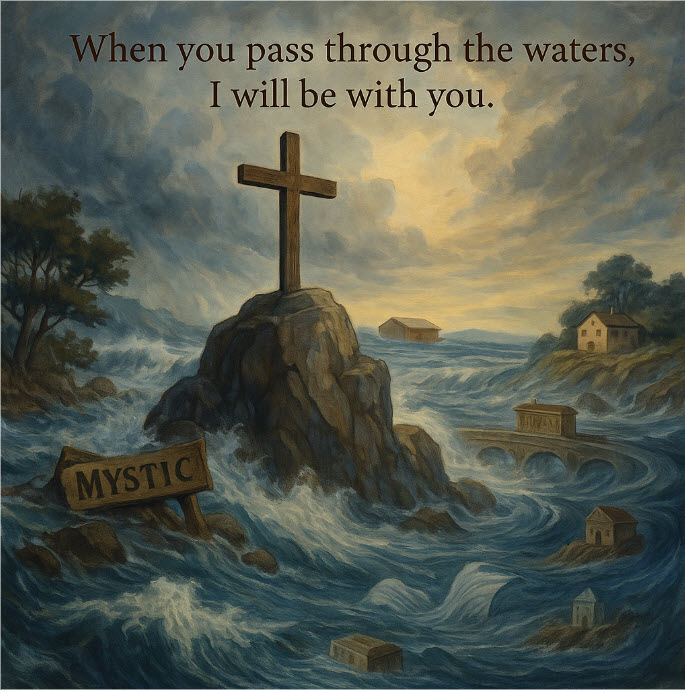We begin with a solemn heart. The flash flood along Texas’ Guadalupe River—most severely near Camp Mystic—surged over 26 feet in just 45 minutes, tragically claiming more than 100 lives.
Among the victims were many Christian girls from Camp Mystic and the camp director, Dick Eastland, who died heroically trying to rescue others.
Counselors like Chloe Childress also gave their lives. Coast Guard teams and first responders rescued over 165 individuals, many putting themselves at risk in the process. Their selflessness stands as a testimony to love, courage and compassion in the face of devastation.
To all who have lost family, friends, or neighbors, we grieve with you. These are not mere statistics but human beings—many believers—whose absence is deeply felt. May our prayers and tears mingle with yours, and may we find understanding and comfort in the pages of Scripture.
Topography Compared: Guadalupe River and Ancient Israel
The Guadalupe River Basin in Central Texas flows through what meteorologists call “Flash-Flood Alley.” The steep canyons of the Hill Country channel heavy rainfall into narrow riverbeds, resulting in rapid, destructive surges. During this recent disaster, water flow exceeded safe channel limits—overwhelming local dams and spilling into residential areas with little warning.
Similarly, ancient Israel’s terrain includes wadis (seasonal riverbeds) and steep valleys prone to flooding. Rainfall in Israel is highly seasonal, often concentrated in short, intense bursts. In places like the Judean wilderness, a sudden storm upstream can unleash torrents downstream. The Kidron Valley near Jerusalem, the Jezreel Valley, and Jordan River’s floodplain are all historical sites of real and symbolic inundation.
Thus, both Israel and Texas share a geological vulnerability: narrow terrain, sudden rainfall, and rapid flooding. These realities make the imagery of flooding in the Bible more than poetic—they are drawn from lived experience.
Fairbairn and Terry on Flood Imagery: Typology and Symbolism
Two giants in biblical interpretation, Patrick Fairbairn and Milton S. Terry, help us understand how flood imagery operates theologically—not just literarily—in Scripture.
Patrick Fairbairn, in The Typology of Scripture, sees the Noahic Flood not only as a historical event, but as a type—a pattern pointing forward to greater spiritual realities. For Fairbairn, the flood represents:
- Judgment on a corrupt world,
- Redemptive separation of the righteous from the wicked,
- And renewal through covenant, as seen in the ark’s preservation of Noah’s family and the rainbow as a sign of peace.
He writes:
The waters of the flood… were the means of executing judgment, but also the medium through which a new world emerged, purified and dedicated to God.
In this view, floods are not merely about wrath—they prepare the way for redemptive restoration.
Milton S. Terry, in Biblical Hermeneutics, adds that natural imagery, including floods, carries multi-layered meaning. He notes that in prophetic literature, floods can symbolize:
- The invasion of nations,
- Divine wrath, or
- Human despair in the Psalms.
Terry insists that to interpret flood imagery properly, one must connect historical context, literary function, and covenantal theology. He treats the biblical flood as an archetype—”a real act of divine judgment that also serves as a mirror for future redemptive acts.”
Together, Fairbairn and Terry illuminate how biblical flood narratives and metaphors are deeply typological, meaning they point beyond themselves toward God’s unfolding plan of salvation.
Old Testament Portraits of Floods
1. Noah’s Flood (Genesis 6–9)
This is the most sweeping flood narrative in Scripture—both in scope and theological significance. God judges the earth’s corruption with water, yet He also provides an ark, a righteous man, and a covenant of peace. As Fairbairn emphasized, the flood is not an end—but a beginning. It sets the stage for God’s covenant faithfulness.
2. The Jordan River at Flood Stage (Joshua 3)
When Israel enters the Promised Land, the Jordan is overflowing. Yet God holds back the waters, just as He did at the Red Sea. This too is a redemptive flood—not of judgment, but of miraculous passage. God leads His people through the waters, not around them.
3. Prophetic Floods of Doom
- Isaiah 8:7–8 likens the Assyrian invasion to a flooding river that rises “up to the neck.”
- Jeremiah 46:7–8 compares Egypt to a Nile flood swelling arrogantly.
- Amos 8:8 warns of a land trembling “like the Nile” in the day of the Lord.
These metaphors use real natural disasters to describe historical events with divine meaning—God sovereignly orchestrates even the floodwaters of politics and war.
David and the Psalms: Floods of the Heart
David, the warrior-poet, knew the terror of floods—not always physical, but emotional and spiritual.
- Psalm 18:4 – “The torrents of destruction assailed me.”
- Psalm 69:1–2 – “Save me, O God! For the waters have come up to my neck. I sink in deep mire…”
David is describing distress, persecution, and spiritual despair. These words help modern believers give voice to grief, especially in the wake of tragedy like Texas. The language of drowning becomes a spiritual metaphor: when life’s sorrows flood over us, we cry out to the God who rescues.
Jesus on Floods: Foundation and Finality
In Matthew 7:24–27, Jesus closes the Sermon on the Mount with a sobering image:
“The rain fell, the floods came, and the winds blew and beat on that house…”
Only one house stands firm—built on the rock of obedience to Christ’s words. Jesus uses flood imagery here to represent not merely hardship, but final judgment. The “storm” isn’t just life’s challenges—it’s the testing of eternal foundations.
We Do Not Presume to Know
Let us be clear: we do not know why God permits specific tragedies. It is deeply unbiblical—and morally appalling—to suggest that the victims of the Texas flood were judged by God for wickedness.
A Texas pediatrician and a college professor made such claims about the children of MAGA voters.
Their remarks dishonored the dead and disrespected the fact that many children who perished were Christians—members of believing families.
Both were motivated by leftist ideology that leads them to believe conservatives and white Americans are uniquely evil.
In Luke 13:1–5, Jesus rebukes such thinking. When asked if Galileans who died under Pilate were worse sinners, Jesus replies:
“Do you think they were worse offenders? No, I tell you… but unless you repent, you will all likewise perish.”
Disasters are not signs that victims are more wicked. They are reminders of life’s frailty and the urgency of repentance. Only God knows why some are taken and others are spared.
These disasters are reminders that life is short and all of us are vulnerable to disastrous deaths. We should live with this knowledge in mind.
But We See Grace in the Flood
And yet, even amid tragedy, we see glimpses of heroic love—reflections of Christ’s self-sacrifice:
- Dick Eastland, Camp Mystic’s director, who died trying to protect the girls.
- Chloe Childress, counselor, who stayed with the children until swept away.
- Coast Guard and rescue teams, who risked their lives to save others.
These acts do not answer the question of why, but they show us how the faithful can respond—with courage, with compassion, and with unwavering hope.
We should also live with the confidence that God is sovereign over each person, and no believer who perished in the Guadalupe River disaster failed to be delivered in a spiritual sense. While God chose not to deliver them from physical death, they were delivered from spiritual death and are experiencing eternal life in the presence of Jesus at this moment.
None of his sheep perished in an eternal sense (John 10:28).
Final Reflection: From Flood to Fulfillment
Floods, both literal and symbolic, run through the Bible like a dark thread woven with gold. They represent death and renewal, judgment and deliverance, fear and faith. From Noah’s ark to David’s psalms, from Isaiah’s warnings to Christ’s parables, the waters speak.
We do not need to fear the flood when we stand on the Rock.
As you continue reading your Bible, consider exploring other imagery drawn from God’s creation—mountains, trees, fire, wind, sheep, stars. Nature is not merely background scenery in Scripture. It is God’s poetic language, meant to stir both heart and mind.
🕊️ In the Wake of the Storm
Let us honor those who have died by seeking wisdom from God’s Word. Let us mourn like David, pray like Jesus, and hope like Noah watching the dove return. The floods may rise—but the Lord is still enthroned.
And, those that belong to the Lord were saved through the flood, even if they have shed their mortal bodies.
When you pass through the waters, I will be with you… the rivers shall not overwhelm you (Isaiah 43:2).
Amen.
S.D.G.,
Robert Sparkman
MMXXV
rob@christiannewsjunkie.com
RELATED CONTENT
Allie Beth Stuckey of Relatable discusses the Texas Flood Disaster. She discusses who is to blame, and how Christians should view this disaster. She is very insightful, and reflects a Christian, feminine perspective that I appreciate.
I did not view this video prior to composing my article.
Concerning the Related Content section, I encourage everyone to evaluate the content carefully.
If I have listed the content, I think it is worthwhile viewing to educate yourself on the topic, but it may contain coarse language or some opinions I don’t agree with.
Realize that I sometimes use phrases like “trans man”, “trans woman”, “transgender” , “transition” or similar language for ease of communication. Obviously, as a conservative Christian, I don’t believe anyone has ever become the opposite sex. Unfortunately, we are forced to adopt the language of the left to discuss some topics without engaging in lengthy qualifying statements that make conversations awkward.
Feel free to offer your comments below. Respectful comments without expletives and personal attacks will be posted and I will respond to them.
Comments are closed after sixty days due to spamming issues from internet bots. You can always send me an email at rob@christiannewsjunkie.com if you want to comment on something afterwards, though.
I will continue to add videos and other items to the Related Content section as opportunities present themselves.

